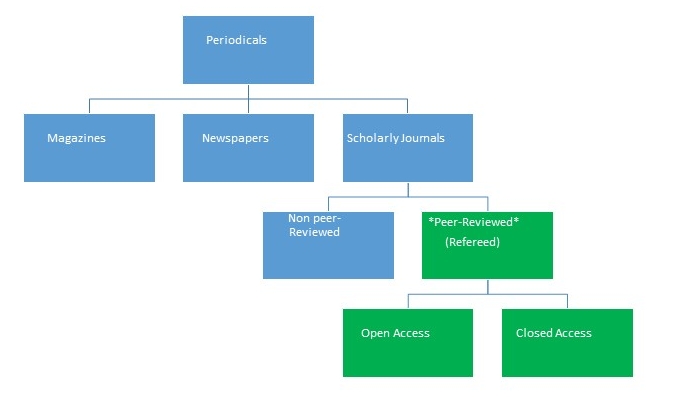How to Identify the Right Journal for Publishing Your Research

Publishing a research project in an academic periodical can be a very challenging task for many researchers. With ever-increasing academic periodicals, selecting a right-fit journal has become a daunting task for both novice and seasoned authors. The authors may wonder what types of periodicals are available for publication, how to find the periodicals, how to evaluate the credibility of the periodicals, and how to select the right fit periodical for publishing their studies. Explanations to answer these inquiries are provided below to further support you as a potential author to publish your study.
Types of Periodicals

There are various types of periodicals available in literature as shown in the above figure. Periodicals are published frequently with a fixed interval between the issues and may include magazines, newspapers, and scholarly journals. Scholarly journals can be categorized into non-peer-reviewed, and peer-reviewed journals. Peer-reviewed or refereed journals are journals that publish articles that were reviewed and approved by at least two reviewers who are experts in the field.
Peer-reviewed journals are the best place for publishing scholarly manuscripts. Peer-reviewed journals are categorized into two groups: closed-access and open-access journals. Articles published in closed-access journals are available only to readers who are subscribed to the journals, while articles published in open-access journals are open to the public. With the latter, the publishing is often paid for by the authors.
It is important to note that open-access journals can sometimes be considered predatory or unacceptable journals in academia. If you elect to publish in an open-access journal, take the needed precautions to verify that the journal is reputable and that a peer review process is in place. Use the criteria provided in the next section to evaluate the credibility of open-access journals.
Finding Journals
After deciding about the type of periodicals to publish, you may wonder about where to find them. You may use several websites and directories to find journals in your field and identify whether they are peer-reviewed, and if they are closed or open access. The following directories provide you with the features of journals including peer-reviewed, access type, and acceptance rate. To access the directories, log into the UOPX eCampus, then click on Library Tab, University Library, and Databases A-Z.
· Cabell’s Scholarly Analytics
· Ulrich’s Periodicals Directory
The following websites provide you with a list of appropriate journals in your field.
· Eric Journals provides a list of credible journals
· Journal Guide gives the option of searching journals based on your keywords and abstract
· Edanz Journal Selector helps you search for journals
· Journal selectors from a few publishers:
Criteria for Evaluating the Credibility of Journals
It is essential to publish your study in an acceptable journal to impact your field and gain recognition and a voice in the community of scholars and practitioners. To evaluate the credibility of a journal the following criteria may be checked in the journal website.
Please note that a combination of all these criteria should be used to properly evaluate a journal.
Peer-reviewed Procedure. The journal should clearly explain its peer-reviewed procedures. A thorough peer-review procedure is one of the most essential factors affecting the credibility of the journals. The peer-reviewed process verifies that the submitted manuscript is rigorous, has a sound method and results, builds on past studies, and contributes to the body of knowledge in the field. Peer-reviewed procedure is a time-consuming process conducted by volunteers who are experts in the field. A very quick turnaround time may indicate a partial peer-reviewed procedure.
Reputation and Ranking. Examining a journal's ranking and reputation is one of the ways to evaluate the journal. Various metrics may be used to rank the journals. The higher score is deemed to present a higher ranking. Some of the most popular journal metrics are:
- Impact Factor is formed based on the average number of citations of the journal articles as indexed in the Journal Citation Report (JCR).
- Scimago Journal Ranking (SJR) is a measure of the scientific influence of a journal that is calculated based on a number of citations indexed in the Scopus database; the score is weighted meaning that citations from more prestigious journals have a higher weight.
Indexed. The journal should be indexed in credible databases such as ERIC, ProQuest, EBSCO, etc. One of the main reasons for publication is sharing your study with a larger audience. Journals that are indexed in credible databases provide more audience to review your article.
Editorial Board Members. The journal should list its editorial board members affiliated with known universities and academic institutions.
Previous Authors. The journal's previous authors should be affiliated with various academic institutions.
Charges and Fees. Credible journals usually would not charge authors for publication. However, charging a fee by itself is not a factor indicating the unacceptability of a journal. Other criteria provided in this list should be considered to evaluate the credibility of the journals. Note that recently some credible publishers may charge a fee for the option of making an article published in a closed-access journal to be available as an open-access article.
Solicitations. Be aware of journal solicitations. Some unknown/predatory journals may send solicitations often via email. Note that some credible journals may also send paper invitations via email. Other provided criteria should be used to evaluate the credibility of the journal.
Predatory or unacceptable Journals. These are journals without adequate credibility and should be avoided. The unacceptable journals often do not peer review the submitted manuscripts and may not pass the above evaluation criteria. All Journals listed in the Directory of Open Access Journals (DOAJ) or Cabell’s Journalytics directory are acceptable. To Identify predatory journals, you may use the following sites:
- Think. Check. Submit, a range of tools to identify predatory journals.
- How to Spot a Predatory Journal (checklist), a checklist to identify predatory journals.
- Predatory reports, a directory of Predatory Journals.
Criteria for Selecting an Appropriate Journal for Your Manuscript

After evaluating the credibility of journals, you may further examine the selected credible journals to identify whether they fit your manuscript. You may use the following criteria to identify the appropriate journals for your manuscript publication.
Scope, Objectives, and Method. Check the objectives of the journal and ensure your manuscript and journal objectives are aligned. This is one of the most important factors in selecting a right-fit journal for your manuscript. Your target journal might be credible and meet all the criteria, yet it may not be a right fit for your manuscript if its scope, aims, and objectives do not match your manuscript objectives. Additionally, ensure that your target journal is interested in your research method. Some journals are interested in a particular research method while others may publish all types of research methods as long as the focus and objective of the studies match with their objectives and aims. If you try to publish a literature review, you should pay closer attention and verify whether the journal is interested in publishing literature reviews.
Issues per Year. A higher number of annual issues increases the chance of acceptance. If you plan to publish in a specific timeframe, you may select a journal that publishes issues within your timeframe.
Acceptance Rate. A higher acceptance rate increases the possibility of being accepted.
Turnaround Time. Some journals have a long turnaround time. Be sure to check the turnaround time as you may submit your manuscript to only one journal at a time.
Author’s Copyrights. Check the author’s copyrights in your target journals. The article copyrights which include the rights for distribution and reproduction of the article are usually transferred to closed-access journals while open-access journals may have different policies.

Mansureh Kebritchi, Ph.D.
ABOUT THE AUTHOR
Mansureh Kebritchi, Ph.D., is an accomplished educational researcher with over 4,470 peer-reviewed citations as of August 2023. Dr. Kebritchi is the founder and chair of the Center for Educational and Instructional Technology Research at the College of Doctoral Studies, University of Phoenix. In addition, she is the founder and leader of Dissertation to Publication and Research to Publication Workshops, Research Methodology Group, and Alumni Research and Support Group. She has a deep passion for educational research and extensive experience as a research methodologist and instructional designer. Dr. Kebritchi is dedicated to mentoring doctoral students and supporting faculty members in their pursuit of conducting and publishing research in the field of education.
More from Mansureh Kebritchi